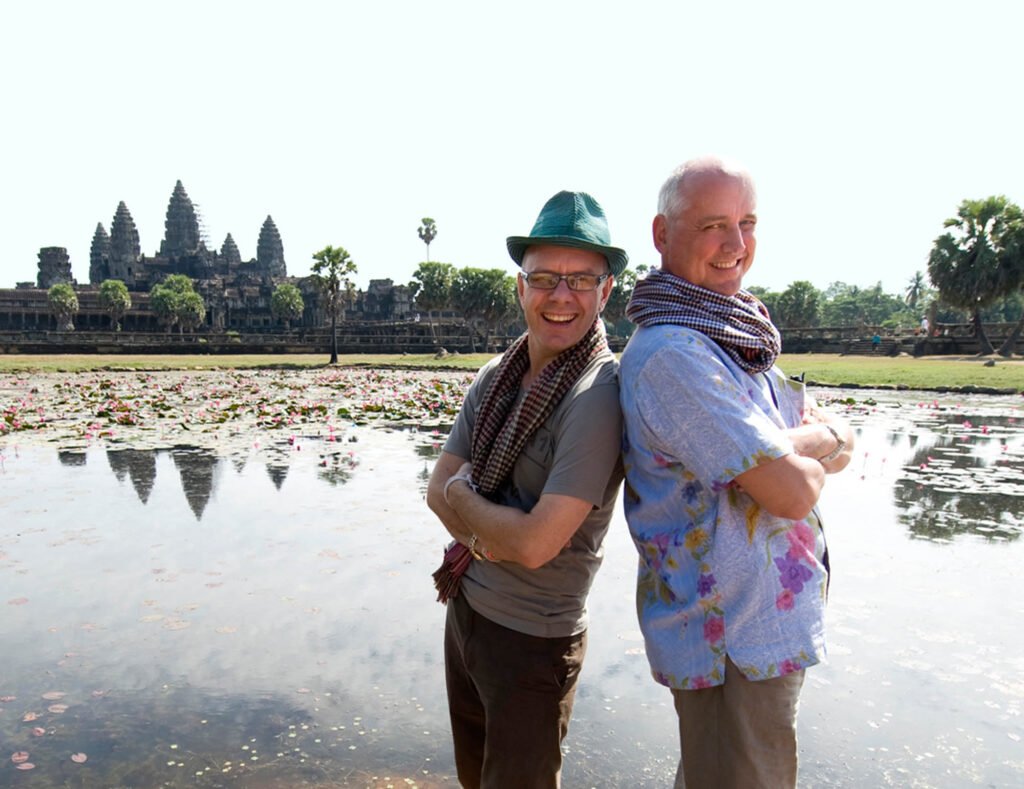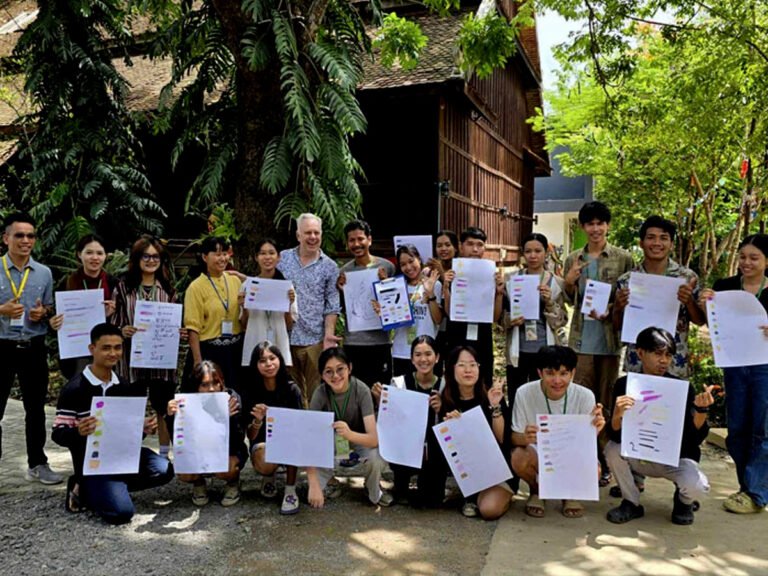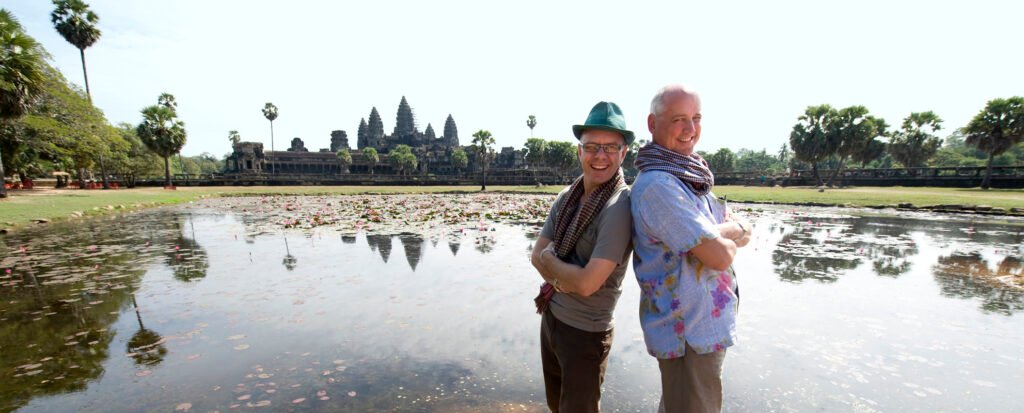Cambodia Tour
Fully escorted small-group tour hosted by
Morrison Polkinghorne and Robert Carmack
June 25 – July 5 2026
WELCOME TO THE KINGDOM OF CAMBODIA, HOME OF THE ANCIENT AND GLORIOUS KHMER EMPIRE & ANGKOR WAT

11 Days, 10 nights
25 June-5 July, 2026

Cambodia is where we lived for almost a decade, owned and ran Bric-à-Brac, an award winning boutique hotel. Southeast Asia is what we know best.
This is a small-group tour hosted and organized by cookbook author Robert Carmack and artist/textile designer Morrison Polkinghorne. Delicious food, delightful company, decorative design and deluxe accommodation: That’s our Globetrotting Gourmet winning recipe since 2002!
A former French protectorate, after years of genocide and civil war Cambodia is regaining its strength and stature. It’s winning a slew of awards for Best Destination in the world, and among the friendliest people in Asia. Join us on our epicurean tour of Cambodia, beginning in capital Phnom Penh, visiting remote ancient temples, viewing arts, weaving and crafts, plus the colonial architecture of Battambang, remote Banteay Chhmar, and famed Angkor Wat in Siem Reap. Plus much more…
“Our heart felt gratitude goes to Morrison and Robert for making our trip to Cambodia truly unforgettable.
Your warmth and hospitality as hosts, combined with your insightful guidance as tour guides, turned our journey into-am extraordinary adventure.
From exploring ancient temples to immersing ourselves into the vibrant culture, every moment was enriched by your knowledge and enthusiasm.
Thank you for creating such wonderful memories with us!”
Day 1
Thursday 25 June
Arrive Phnom Penh
Welcome to Phnom Penh, once described as The Pearl of Asia. Today it’s a vibrant cosmopolitan city, despite its relatively small population of nearly 2 ½ million.
You will be met at the airport by a Globetrotting Gourmet representative and driven to our host hotel.
Need extra nights? Just ask for pre- and post extension advice.
Day 2
Friday 26 June
Colonial Phnom Penh + lunch
Colonial Phnom Penh was considered the “Pearl of the Orient” and today considered an historical gem, with both its Deco and post ’53 independenceKhmer Moderne architecture lauded. Today we tour its colonial heart by pedicab, followed by lunch is at the city’s finest eatery; refined dining at its best. The menu is modern Khmer, and we’ve selected specialties that are sure to excite the taste buds.
Remaining afternoon and evening free to rest and recover after long flights, or alternatively discover Phnom Penh on your own: visit the Tuol Sleng prison, a school used by the Khmer Rouge to interrogate its citizens, or further afield the Killing Fields. Both are highly recommended viewing, giving eyewitness testimony to the horrors of Khmer Rouge rule in Cambodia. As these are sobering experiences, we recommend viewing quietly in solitude, and not with a group. B/L
Day 3
Saturday 27 June
Penh’s Hill, Museum & Royal Palace
Founded in the mid 15th century, Phnom Penh is built on the confluence of the Tone Sap, Bassac, Mekong rivers and tributaries. Originally named Chaktomuk for its “four faced” river crossroads, Phnom Penh was named Penh’s Hill after Lady Penh discovered images of the Lord Buddha and Lord Vishnu inside a floating tree. Lady Penh increased the height of the district’s nearby small hill, and constructed temples there to house these sacred relics. The main temple eventually became known as Wat Phnom Dau Penh, with the city’s name eventually shortened to Phnom Penh. This eventually became the country’s capital in the mid 19th century. This morning, climb Penh’s Hill and get a brief historical introduction to the city, followed by the city’s domed Psar Thmei Central Market, a deco treat constructed in 1935. View local crafts and shopping street highlights. Lunch is at a buzzy new eatery featuring Khmer classic dishes served très à la mode.
After lunch, visit the Cambodia’s National Museum and the Royal Palace. Although looted during the dark days of Khmer Rouge mis-rule, both are still treasure troves of unexpected delights. Most surprising are the museum’s collection of ancient Egyptian, Greek and Roman-influenced figurines and artifacts dating to the 6th century Pre-Angkorian civilizations — attesting to this region’s early trade routes.
We finish the day with a sunset cruise on the Mekong, followed by traditional al fresco grill fare. The seafood fresh, the beer cold and plentiful, and adventurous Khmer supping in a bustling setting.
B/L/D
Day 4
Sunday 28 June
Hotel check out, then early lunch before leaving Phnom Penh at one of the city’s most bustling and best coffee shops to sample the national dish of bai sai chrout grilled pork on rice, and milky coffee or tea.
Today we drive to the colonial city of Battambang, second largest city in the kingdom, but much more like a big village in atmosphere and appearance.
Enroute stop at Pursat to view marble carving plus brief introduction to the local pickled bamboo shoots and wild honey. Regroup for hotel dinner, a specially prepared spread of Northwest delights, including Battambang speciality som wak fermented fish parcels.
B/L/D
Day 5
Monday 29 June
Walking tour of colonial Battambang, which was officially nominated for Unesco Heritage status for its French colonial buildings. Begin at the city’s recently renovated provincial museum highlighting ancient Khmer statues and artifacts from the region, then to the inspiring Naga snake statue forged from guns surrendered by the Khmer Rouge. From about 1908 until 1953 Cambodia was a French protectorate, but for nearly two centuries prior Battambang and most of Northwest Cambodia was under Thai tutelage. Surprisingly, you will discover that the rococo Governor’s Mansion is not French at all, rather built by Italian architects during the city’s Thai sovereignty. Be sure to note the myriad public murals around town, cementing contemporary Battambang’s art reputation.
Free Time: visit the old teak homes in Wat Kor, or in town go on a gallery crawl to view contemporary art. The city has more artists per capita than any other. There is plenty to do in Battambang, or simply sit back and relax.
Late afternoon departure for Phare Ponleu Selpak, a non-profit arts school for nearly 1000 impoverished students.
We’ve arranged a school tour plus cooking demo with lots to eat. Followed by evening attendance at the school’s famous athletic circus (no animals).
(There is a sister circus performance in Siem Reap, but without the attached school.)
B/S/D
Morrison will teach an art techniques workshop at Phare this afternoon.

Day 6
Tuesday 30 June
This morning the group splits in two: bike tour for the energetic, or tuktuk for the rest of us. Meet for an optional espresso at Kinyei, whose name means ginger, and is a popular stop for both expats and locals. Then onto Battambang’s food culture watching rice sheets being made for spring rolls, a rice distillery, and khao lam, a local specialty of stuffed and grilled coconut rice in bamboo (it’s extremely labour intensive). Vist a Khmer “cheese” factory where artisans dry fish for prahok, Cambodia’s national condiment.
Optional: take the Bamboo railway, a form of transport uniquely developed post Khmer Rouge to facilitate transport.
As it’s our last night in Battambang dinner is organized at a very traditional Khmer restaurant by our former Bric-a-Brac staff; a unique chance to meet the locals. Expect a free flow of beer, soft drinks and customary snacks, and most of all lots of fun. B/S/D
Day 7
Wednesday 1 July
To Banteay Chhmar, Siem Reap
Banteay Chhmar is one of the largest ancient Khmer temples in Cambodia, but little visited because of its isolation. Its massive wall friezes are extraordinary. (There are rumors a Thai politician absconded with two of them in the 1990s which now grace his back garden in Bangkok.) There is a small French silk factory in the village. Time permitting, visit nearby Banteay Tuop, whose weathered towers have the distinction of retaining a few wooden ceiling planks still in situ. Lunch at a local eatery near the temple prepared by the village co-op, then continue to Siem Reap.
As this has been a long day tonight is free for your personally exploration. Our hotel’s location is central in town, and there are numerous restaurants and upmarket bars (and some decidedly shady if that is your preference lol!) There’s also massage, facials, mani-pedis options abounding. Ask us for recommendations.
B/L
Day 8
Thursday 2 July
Seam Reap, Floating Village, Water Blessing
This morning we’ll have a break from temples, starting at Siem Reap’s Old Market to explain local foodstuffs, buy trinkets and souvenirs, sample local snacks. Onto a monk’s water blessing, Proh Prom Teuk Mon, welcoming us to the region. Lunch is at a very special restaurant training school that we’ve supported for years, followed by the floating villages of Tonle Sap. There are three different location choices, and we’ve chosen the best! Here catch a view of life on Cambodia’s most famous lake. Contrary to all laws of nature, the mighty Mekong annually flows backward into the Great Lake, increasing its size by some four times, and enriching the locals with a bounty of fish and irrigation water. Optional sunset on the temples.
B/L
Day 9
Friday 3 July
Traditionally the Angkor complex has been broken into two areas: Succinctly, the very busy Small Circuit is for the main attractions; Grand Circuit offers a more diverse selection of temples in a less crowded environment. Visit Ta Prohm, Bayon, and the South Gate. Continue through the West Gate of Banteay Kdei to regroup at the royal Barry or reservoir, Srah Srang. In the afternoon, the jewel in the crown: Angkor Wat. What more can one say about the vast spectacle of Angkor Wat, except that it is truly an awe-inspiring, breathtaking experience. This is the largest temple in the world, as tall as Notre Dame cathedral, and its stone volume equals Cheops’ Great Pyramid in Egypt. Dinner is at a popular Khmer restaurant tasting a wide range of grilled meats.
B/D
Day 10
Saturday 4 July
Today travel to the Grand Circuit exploring outstanding temples and Khmer sacred sites less frequented. Out first stop, Banteay Srei.
Banteay Sprey/Srei boasts some of the finest carved lintels existing, unique in pink stone. Often referred to as the “Citadel of Women” (or “beauty”) and unlike others, it was not constructed as a royal temple. Onto Banteay Samre, a fine example of small scale Angkor architecture. Its size permits you to closely appreciate its fine intricacte carvings that are often dwarfed by the immense size of larger temples. Local lunch in the countryside, then onto East Mebon — formerly an island temple in the now-depleted Eastern Baray reservoir. As this is our last night, we have scheduled a formal Khmer dinner especially for you, so put on your fanciest frocks!
B/L/D
Day 11
Sunday 5 July
Tour ends today.
After breakfast, we include private transfers back to the airport. For those wishing to extend their stay in Siem Reap, ask us for special hotel rates and additional services. BONUS: Your 3-day Angkor entry ticket is still valid today. B/
GETTING THERE:
Cambodia hosts numerous international carriers with direct routes to and from the national capital Phnom Penh and to Siem Reap, home of the famed Angkor temples. The two cities Phnom Penh (PNH) and Siem Reap (REP) are common routed, so many airlines allow arrival into PNH and departure from REP (or vice versa) without penalty.
International: Most popular transits are via Vietnam/HCM, Singapore/SIN, Malaysia/KUL, Thailand/BKK, plus further afield China, Hong Kong, Taiwan, Japan, Korea.
When arranging international flights for this tour, ensure your travel agent flies you into Phnom Penh, but out of Siem Reap. If this is not possible, a domestic Siem Reap to Phnom land transit or flight may be required, which we can help organize. NB: we do not recommend Cambodian domestic to international connecting flights on the same day.
Some carriers, especially discount carriers like Air Asia, do not allow international baggage transfers; in which case, you may need to physically collect your bags at your intermediary airport then check in a second time. (Bangkok Air is a notable exception.)
Domestic carriers: There are also direct flights Siem Reap to Sihanoukville for those wishing to visit the Cambodian islands post tour. For those planning visits to Kampot and Kep, it is quicker to drive from Phnom Penh, or by the restored train line, the latter operating on weekends only (Fri, Sat & Sun).
Tour hosts since 2002

